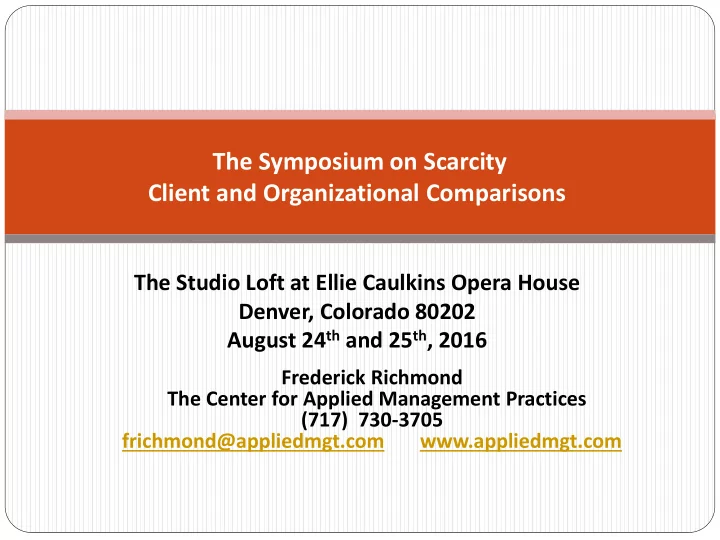

The Symposium on Scarcity Client and Organizational Comparisons The Studio Loft at Ellie Caulkins Opera House Denver, Colorado 80202 August 24 th and 25 th , 2016 Frederick Richmond The Center for Applied Management Practices (717) 730-3705 frichmond@appliedmgt.com www.appliedmgt.com
Income/Revenue Clients-Benefits/Income from third parties. TANF, SNAP, Medicaid/Medicare/CHP, LIHEAP, WIC, MCH, CSBG, CDBG, Weatherization, Section 8, Public Housing, Child Care, Other. Time limited, must meet specific eligibility requirements. Funds are restricted or programmatic. No free cash. Client requests a specific benefit(s). Frederick Richmond, The Symposium on Scarcity, Denver, CO, 8/24/16, frichmond@appliedmgt.com
Income/Revenue Organizations-Income/Revenue usually from third parties. Administrative fees obtained for providing CSBG, CDBG, LIHEAP, etc. Time limited, qualifications for public and private grants. Funds are programmatic or restricted. No free cash. Organization goes after the grant(s). Frederick Richmond, The Symposium on Scarcity, Denver, CO, 8/24/16, frichmond@appliedmgt.com
Seeking/Applying for Resources Client-Comes to organization usually as a last resort. Does not necessarily want to be there. Applies for benefits. Dependent on organization’s direct and/or referral services. Lives on the subsidized benefit. Rarely have their own resources or source(s) of income. Lives day-to-day. For most clients, ongoing need for benefits or income. Frederick Richmond, The Symposium on Scarcity, Denver, CO, 8/24/16, frichmond@appliedmgt.com
Seeking/Applying for Resources Organization-Applies for grant funds as the only or last resort. Executive Director primarily role is to seek funds. Applies for resources. Dependent on other organizations for funding. Lives on the grant or other public and private third party funding. Rarely have their own resources or sources of income. Lives year-to-year. Ongoing need, always looking for the next grant. Frederick Richmond, The Symposium on Scarcity, Denver, CO, 8/24/16, frichmond@appliedmgt.com
Wages/Salaries/Benefits-Clients Many clients have significant income equivalents or “unearned income” greater than the Colorado minimum wage of $8.31/hour. Many clients have significant income equivalents or “unearned income” closer to a living wage defined as 200% of poverty or $20.68/hour. Clients frequently do not recognize the economic value of subsidized benefits as an “unearned” source of income. Frederick Richmond, The Symposium on Scarcity, Denver, CO, 8/24/16, frichmond@appliedmgt.com
2016 HHS Poverty Guidelines with Hourly Wage Calculations Frederick Richmond, The Symposium on Scarcity, Denver, CO, 8/24/16, frichmond@appliedmgt.com
Cliff Effect-Sample Programs, Income Eligibility and Value of Subsidized Benefits Frederick Richmond, The Symposium on Scarcity, Denver, CO, 8/24/16, frichmond@appliedmgt.com
Wages/Salaries/Benefits-Organizational Staff Staff salaries are likely less than 200% of poverty or $20.68/hour for a single wage earner in a family of three. Staff often do not recognize the economic value of subsidized benefits provided to the clients. They may only be providing a specific service and do not have an overall “picture” of the entire benefit package. Staff frequently state that their clients are better off than they are. Agencies have staff that are also clients; eligible and receive benefits while working at the agency. Some staff may have been former clients. Some staff become clients when they recognize the Frederick Richmond, The Symposium on Scarcity, Denver, CO, 8/24/16, frichmond@appliedmgt.com value of subsidized benefits.
Effects on Health-Clients Low-income clients are at greater risk of physical and mental illness and seek treatment further along the illness process. Mental stress of being poor is a major reason that low-income people are more likely to have high blood pressure, cholesterol, and become obese or diabetic, since long-term stress creates hormones that compromise the immune system and promote weight gain. Low-income people are more likely to smoke and have less access to fresh food. Frederick Richmond, The Symposium on Scarcity, Denver, CO, 8/24/16, frichmond@appliedmgt.com
Effects on Organizations-Staff Social Service workers and truck drivers are least likely to meet the seven ideal metrics of heart health: 1.Refraining from smoking, 2.Physically active, 3.Normal blood pressure, 4.Normal blood glucose, 5.Ideal weight, 6.Registered normal cholesterol, 7. Healthy diet. A study published in 2016 by the Center for Disease Control followed 66,000 employees in 22 occupations and 21 states: 3.5% of all workers met all seven metrics. Meeting 6/7 metrics is associated with less likelihood from dying of heart disease. 9.6% of workers only met 2 or fewer metrics, but Frederick Richmond, The Symposium on Scarcity, Denver, CO, 8/24/16, frichmond@appliedmgt.com 14.6% of social service workers met 2 or fewer metrics.
Client Behavior Element of a crisis. Obtain services to achieve stability and reduce or eliminate crises. Set goals, establish a plan, self-manage, implement the plan and document progress on achieving results or outcomes. Become less dependent and more self- sufficient. Frederick Richmond, The Symposium on Scarcity, Denver, CO, 8/24/16, frichmond@appliedmgt.com
Organizational Behavior-P1 Frequently in “firefighter” mode; element of a crisis. Unsure of on-going funding, staff unsure if they have on-going employment. Obtain on-going resources to achieve organizational stability, reduce or eliminate crises and have sufficient resources to provide services and meet clients needs. Create a Strategic Plan for short and long goals. Have an Operational Plan for daily service delivery. Link services and outcomes to the budget and share this information with all staff. Frederick Richmond, The Symposium on Scarcity, Denver, CO, 8/24/16, frichmond@appliedmgt.com
Organizational Behavior-P2 Ensure that the Strategic Plan and the organization is information driven. Document the service delivery process. Document the expected results/outcomes for programs and clients. Proactively “market” the organization's results or outcomes to the community. Proactively “market” the organization's results or outcomes to existing and prospective funders. Frederick Richmond, The Symposium on Scarcity, Denver, CO, 8/24/16, frichmond@appliedmgt.com
Organizational Assessment-Answer These Questions Carter-Richmond Methodology 1. How many clients are you serving? 2. Who are they? 3. What services do you give them? 4. What does it cost? 5. What does it cost per service delivered? 6. What happens to the clients as a result of the service? 7. What does it cost per outcome? -------------------------------------------------------------------- 8. What is the value of a successful outcome? 9. What is the return on investment? Frederick Richmond, The Symposium on Scarcity, Denver, CO, 8/24/16, frichmond@appliedmgt.com
Recommend
More recommend